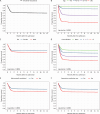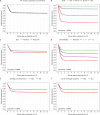Long-term mortality of Dutch COVID-19 patients admitted to the intensive care medicine: a retrospective analysis from a national quality registry
- PMID: 39775432
- PMCID: PMC11463994
- DOI: 10.62675/2965-2774.20240251-en
Long-term mortality of Dutch COVID-19 patients admitted to the intensive care medicine: a retrospective analysis from a national quality registry
Abstract
Objective: To describe the 12-month mortality of Dutch COVID-19 intensive care unit patients, the total COVID-19 population and various subgroups on the basis of the number of comorbidities, age, sex, mechanical ventilation, and vasoactive medication use.
Methods: We included all patients admitted with COVID-19 between March 1, 2020, and March 29, 2022, from the Dutch National Intensive Care (NICE) database. The crude 12-month mortality rate is presented via Kaplan-Meier survival curves for each patient subgroup. We used Cox regression models to analyze the effects of patient characteristics on 12-month mortality after hospital discharge.
Results: We included 16,605 COVID-19 patients. The in-hospital mortality rate was 28.1%, and the 12-month mortality rate after intensive care unit admission was 29.8%. Among hospital survivors, 12-month mortality after hospital discharge was 2.5% (300/11,931). The hazard of death at 12 months after hospital discharge was greater in patients between 60 and 79 years (HR 4.74; 95%CI 2.23 - 10.06) and ≥ 80 years (HR 22.77; 95%CI 9.91 - 52.28) than in patients < 40 years of age; in male patients than in female patients (HR 1.38; 95%CI 1.07 - 1.78); and in patients with one (adjusted HR 1.95; 95%CI 1.5 - 2.53), two (adjusted HR 4.49; 95%CI 3.27 - 6.16) or more than two comorbidities (adjusted HR 4.99; 95%CI 2.62 - 9.5) than in patients with no comorbidities. Neither vasoactive medication use nor mechanical ventilation resulted in statistically significant results.
Conclusion: For Dutch COVID-19 intensive care unit patients, most deaths occurred during their hospital stay. For hospital survivors, the crude 12-month mortality rate was low. Patient age (older than 60), sex and the number of comorbidities were associated with a greater hazard of death at 12 months after hospital discharge, whereas mechanical ventilation and vasoactive medication were not.
Objetivo:: Descrever a mortalidade em 12 meses de pacientes holandeses com COVID-19 internados em unidades de terapia intensiva, a população total com COVID-19 e vários subgrupos segundo o número de comorbidades, idade, sexo, ventilação mecânica e uso de medicação vasoativa.
Métodos:: Incluímos todos os pacientes admitidos com COVID-19 entre 1° de março de 2020 e 29 de março de 2022, do banco de dados do registro holandês National Intensive Care Evaluation (NICE). A taxa bruta de mortalidade em 12 meses é apresentada por meio das curvas de sobrevida de Kaplan-Meier para cada subgrupo de pacientes. Usamos modelos de regressão de Cox para analisar os efeitos das características do paciente na mortalidade em 12 meses após a alta hospitalar.
Resultados:: Incluímos 16.605 pacientes com COVID-19. A taxa de mortalidade hospitalar foi de 28,1%, e a taxa de mortalidade em 12 meses após a admissão na unidade de terapia intensiva foi de 29,8%. Entre os sobreviventes hospitalares, a mortalidade em 12 meses após a alta hospitalar foi de 2,5% (300/11.931). O risco de morte em 12 meses após a alta hospitalar foi maior em pacientes entre 60 e 79 anos (HR 4,74; IC95% 2,23 - 10,06) e ≥ 80 anos (HR 22,77; IC95% 9,91 - 52,28) do que em pacientes < 40 anos de idade; em pacientes do sexo masculino do que do sexo feminino (HR de 1,38; IC95% 1,07 - 1,78); e em pacientes com uma comorbidade (HR ajustado 1,95; IC95% 1,5 - 2,53), duas comorbidades (HR ajustado 4,49; IC95% 3,27 - 6,16) ou mais de duas (HR ajustado 4,99; IC95% 2,62 - 9,5) do que em pacientes sem comorbidades. Nem o uso de medicação vasoativa nem a ventilação mecânica apresentaram resultados estatisticamente significativos.
Conclusão:: A maioria das mortes de pacientes holandeses com COVID-19 na unidade de terapia intensiva ocorreu durante a internação hospitalar. Para os sobreviventes do hospital, a taxa bruta de mortalidade em 12 meses foi baixa. A idade do paciente (acima de 60 anos), o sexo e o número de comorbidades foram associados a um maior risco de morte 12 meses após a alta hospitalar, enquanto a ventilação mecânica e a medicação vasoativa não foram.
Conflict of interest statement
Figures




References
-
- Brinkman S, Termorshuizen F, Dongelmans DA, Bakhshi-Raiez F, Arbous MS, de Lange DW, de Keizer NF, Dutch COVID-19 Research Consortium Comparison of outcome and characteristics between 6343 COVID-19 patients and 2256 other community-acquired viral pneumonia patients admitted to Dutch ICUs. J Crit Care . 2022;68:76–82. - PMC - PubMed
-
- Brinkman S, de Jonge E, Abu-Hanna A, Arbous MS, de Lange DW, de Keizer NF. Mortality after hospital discharge in ICU patients. Crit Care Med . 2013;41(5):1229–1236. - PubMed
MeSH terms
LinkOut - more resources
Full Text Sources
Medical

